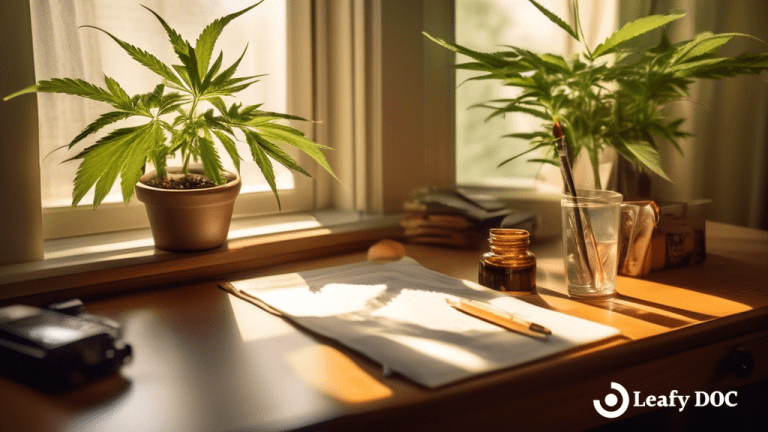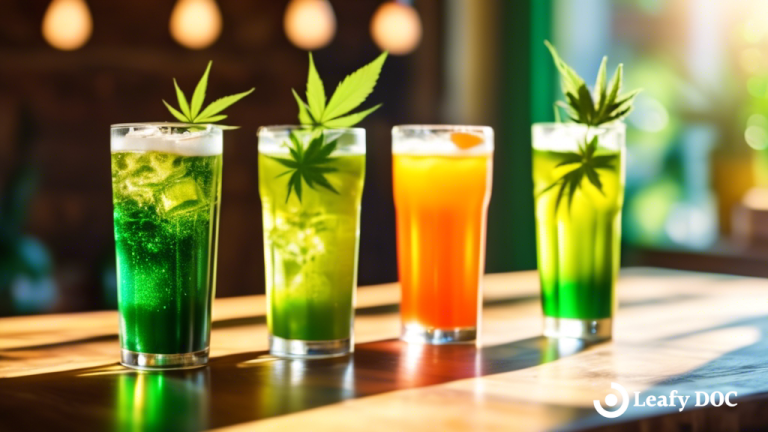The Development of Cannabis Trichomes
by Haley Mills · March 22, 2023
Learn how the diverse trichomes of cannabis plants provide protection and produce cannabinoids, terpenes, and flavonoids. Explore their development and function!

You may have noticed tiny hairs that may be clear, white, amber, or brown on your buds. Not to worry, these are incredibly important to the cannabis plant. Not only do they provide protection, but they may also influence potency and flavor profiles. Read on to learn more about weed trichomes.
What are trichomes?
Trichomes are tiny, hair-like growths found on many plants, lichens, algae, and protist organisms. A protist organism has cells with a nucleus but is neither animal, plant, or fungus. Cannabis trichomes are shaped like a mushroom. A stalk supports the bulbous, spherical head, and they are about 50-100 microns wide. Cannabis plants seem to use them to help defend themselves.
Three Types of Trichomes
There are three primary types of glandular trichomes in cannabis strains: bulbous, capitate-sessile, and capitate-stalked. We’ll explore their differences in this section.
Bulbous trichomes
Bulbous trichomes are tiny bulbs evenly distributed over the surface of the cannabis plant and contain minor amounts of THC. They can only be seen with a microscope. They have a crystal-like shiny appearance and are incredibly sticky due to the resin glands.
They can be recognized by the one-cell stalks and gland heads that swell with natural oil. Their primary purpose is to alert plants of intruders and protect the cannabis flowers from the sun.
capitate-sessile trichomes
Capitate sessile trichomes are bigger and more abundant than bulbous trichomes. They are still small enough that they are only visible through a microscope. Capitate sessile trichomes are mushroom-shaped and attached to the cannabis plant without a stalk. During cannabis cultivation, they can be found at the bottom of sugar leaves and fan leaves.
These trichomes produce cannabinoids throughout the lifecycle of a cannabis plant but at much lower levels than capitate-stalked trichomes. Because they make fewer cannabinoids, they are considered the best option for edibles and cannabis concentrates.
capitate-stalked trichomes
Capitate-stalked trichomes are the largest and most prominent of the types. They are mushroom-shaped with large bulbs at the head of the stalk of female cannabis plants. They can typically be seen with the human eye.
Capitate-stalked trichomes are often found on sugar leaves, fan leaves, and stems and can grow up to 500 micrometers. When these peak density after the flowering process, the cannabis plant has the highest quantity of desirable cannabinoids and terpenes.
How to Examine Trichomes
Carefully observing trichome development and production during a cannabis plant’s growth process is vital to its success. By following the color and opacity of trichomes, you can determine the best harvest time for the experience you want. There are several trichome stages, and inexperienced growers can benefit from referencing trichome color and harvest charts.
Trichome size can range from ten to five-hundred micrometers. These tiny hair-like structures are best observed through a microscope though some can be seen with the eye alone. Cannabis growers typically focus on the mushroom-shaped trichomes, as they contain the majority of the cannabinoids and can be a sign that harvest time is near.
Vegetative & Flowering Phase
Your marijuana plants will enter the three to sixteen weeks, known as the vegetative stage. Your female marijuana plant will need at least sixteen hours of light or six hours of direct sunlight, with several hours of indirect sunlight to follow. At this stage, you’ll want to provide nutrients, water, and maintenance to your cannabis plants.
The flowering stage lasts eight to twelve weeks and is the final step to producing high grade cannabis buds. This is where the twelve hours of sun and dark come into play. If you take good care of your plants, they should begin to produce large, resinous buds with high contents of resin production. This is the last stage before it is time to harvest.
Do trichomes affect cannabinoids & terps?
Cannabinoids and terpenes are both active chemical compounds found in cannabis plants. While cannabinoids are considered primarily responsible for the euphoric effects and medicinal benefits associated with cannabis Sativa, terpenes remain the source of the cannabis plant’s aroma and taste. However, when cannabinoids and terpenes combine, they create a synergistic effect on the human endocannabinoid system. The two complement and enhance the sum of their therapeutic or euphoric properties.
The production of trichomes, as well as the stage they are in during harvest can affect the amount of THC, CBD and other cannabinoids are present while harvesting cannabis flowers. The terpenes that control flavor and aroma and the amount of cannabis resin on the buds are also influenced by cannabis trichome development.
Do some cannabis plants not produce trichomes?
Poor genetics, bad cannabis seeds, or adverse environmental conditions are the two leading causes of cannabis buds not producing trichomes. Even with good genetics, a cannabis plant can only reach its full potential if the growing conditions are ideal. Common causes of poor trichome production include over and underfeeding during the flowering stage, waterlogged roots, bud rot, mold, temperature or humidity extremes, pests, and disease.
Four Stages of Development
The four main stages of trichome development are clear, cloudy or milky, amber, and mixed. So, what does each stage represent?
Clear trichomes
Clear or milky trichomes are the first to appear on the cannabis plant during the transition from the vegetative stage to the flowering period. During this time, the trichomes will appear transparent or opaque under a microscope. This clearly indicates that the plant is still creating THC and is not ready for harvest.
Harvesting buds too early in trichome development can produce a potentially uncomfortable experience for the user. However, clear trichomes’ appearance throughout the lifecycle indicates healthy growth.
cloudy trichomes
When a trichome appears cloudy or milky, this indicates that THC levels are beginning to begin to reach their full potency, flavor, and aroma. At this stage, the plant is almost mature but not quite and growers tend to wait; the buds will seem small and lack aroma. When cloudy trichomes cover the buds, THC levels are higher than CBD, and the psychoactive effects are more intense. Trichomes remain milky for approximately two weeks during their lifecycle.
amber trichomes
Trichomes turn amber in conjunction with milky trichomes. The transition occurs slowly, and you can see the change through a microscope. A cannabis plant covered in 70 percent amber trichomes will have higher levels of CBD and CBN.
During this stage, the tiny white trichome glands appear dark orange or brown. The medical marijuana industry and MMJ cannabis consumers uses weed harvested at this stage to manage chronic pain and treat sleep disorders. Many Indica-dominant strains are harvested once the trichomes have turned amber for medicinal properties.
mixed trichomes
Many growers prefer to harvest marijuana when it has a mixture of milky and amber trichomes. In fact, the preferred ratio is often 70/30 amber to cloudy. Buds harvested with this ratio of trichome colors are frequently processed for the recreational community to create energizing and euphoric cerebral effects. At this stage, the trichomes are delicate and must be protected during processing to benefit producers and consumers.
Are You Ready for Harvest?
First, you’ll want to take a close look at your cannabis plants right before it is time to harvest. Things to look for are damage due to nutrient or water deficiency, natural occurrences, disease, and mold. Instead of removing the entire plant, if it’s possible, you can trim off any damaged pieces and throw them out.
While every cannabis strain has an estimated harvest time indoors and outdoors when to harvest for trichome production primarily depends on personal preference. One of the significant advantages of growing cannabis at home is that you determine when to gather it. For some, early harvesting offers a welcomed energetic high. The trichomes will still be clear and colorless, and although the yields may be smaller, some growers love early-harvested buds so much that it doesn’t seem to matter.
Most growers wait until about seventy percent of the trichomes are cloudy, and the other thirty percent turn amber. Waiting increases yields and offers a more potent and balanced high that many users prefer.
If you wait until most trichomes are dark amber or red, the high will be more soothing than energetic. Due to the amount of CBN in dying plant cells, late harvesting can lead to a profoundly relaxing and “couch lock” experience.
In summary, the harvesting time will depend on what you want from the weed and the experience it offers. We recommend studying your strain of choice before growing it for trichome production purposes.
Last Updated: August 8, 2024
Get Approved for Your Medical Marijuana Card in Minutes!

Get Your Medical Card
Connect with a licensed physician online in minutes

Like This Article?
Share with your friends
Table of Contents
Keep Reading
-
Enhancing Focus And Concentration With Terpenes In Cannabis
Unlock your productivity potential with the power of terpenes in cannabis! Boost focus and concentration naturally. Click here to enhance your performance today!
-
How to Obtain Your Hawaii Medical Marijuana Card Easily
Learn how to easily obtain your Hawaii medical marijuanas card with simple steps and guidance.
-
Refreshing Cannabis-infused Beverage Recipes To Try
Indulge in a selection of refreshing cannabis-infused beverage recipes for an elevated experience. Try these delicious drinks today and treat yourself to a rejuvenating sip of relaxation!



